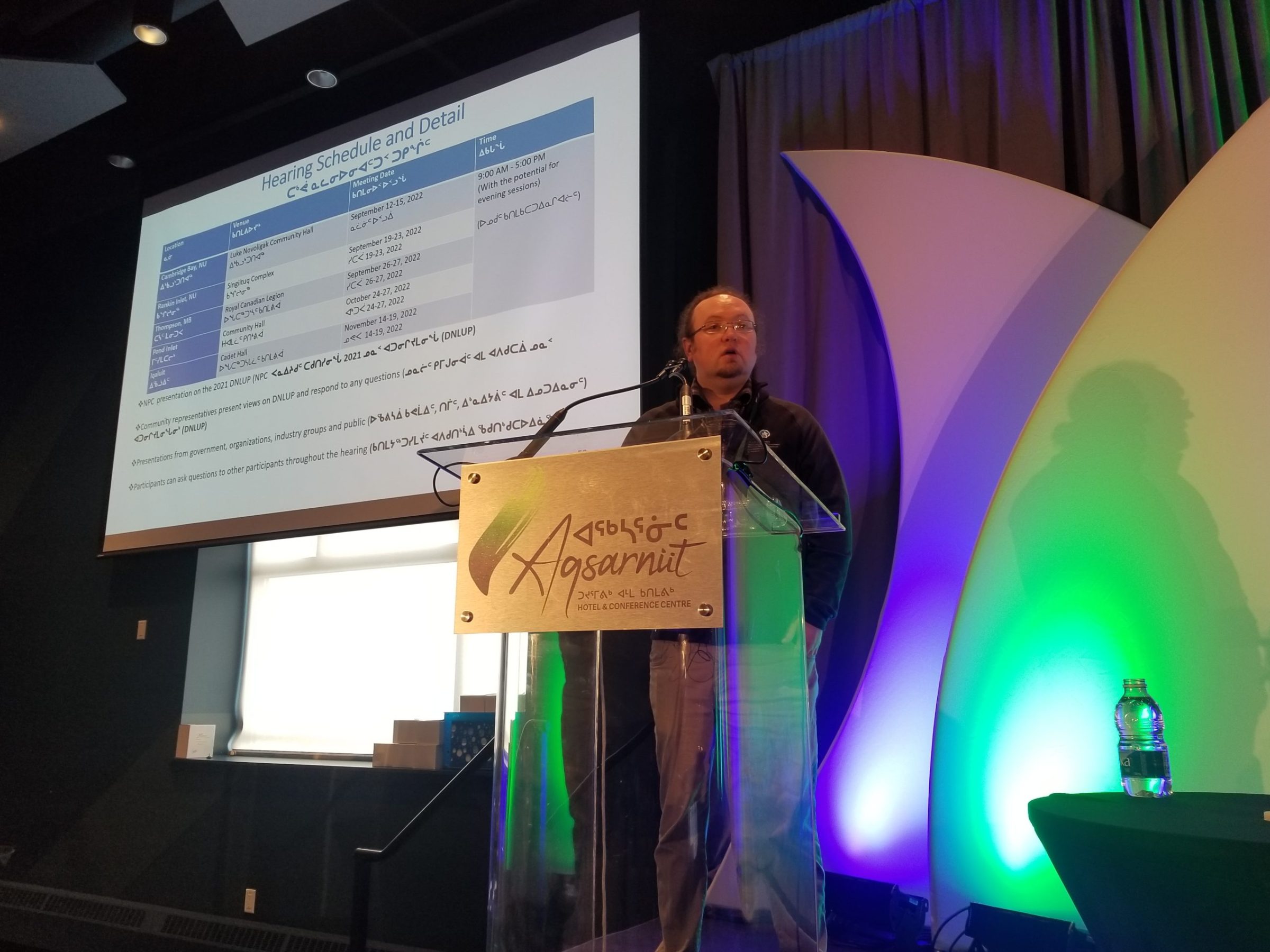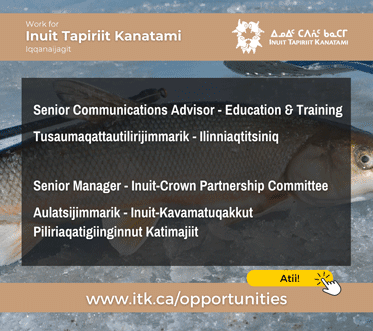Caribou protection called most problematic area of draft land-use plan
Nunavut Planning Commission to hold public hearings on new draft plan later this year
Nunavut Planning Commission policy director Jonathan Savoy speaks Wednesday morning at the Nunavut Mining Symposium, held at the Aqsarniit Hotel in Iqaluit. (Photo by David Venn)
The Nunavut Planning Commission says caribou protection is the top concern it hears about when it comes to its draft land-use plan.
An overview of the plan was presented by director of policy and planning Jonathan Savoy and executive director Sharon Ehaloak at the Nunavut Mining Symposium in Iqaluit Wednesday morning.
The commission gathered data on caribou habitat, such as what they are sensitive to, from the Government of Nunavut’s collar tracking program and Inuit Qaujimajatuqangit, or traditional knowledge, Savoy said.
“The commission has received extensive information on … a variety of perspectives on how [caribou] should be managed within these areas,” he said.
It considered information on calving areas, post-calving areas and fresh water crossings for caribou, to determine which sites should be protected or be permitted for commercial use.
The commission released the draft land-use plan — which Ehaloak called the largest land-use plan in the world — last July.
It differs from the 2016 draft by having more protected areas — 22 per cent of land that commercial activity will not be allowed on — while protecting mining companies’ existing rights by making it easier to amend the plan for future development, among many other changes.
Ehaloak said the process has been difficult.
“Is it perfect? No, it’s a draft,” she said Wednesday at the symposium at the Aqsarniit Hotel in Iqaluit. “The commission’s task is daunting, but we’re up for that challenge.”
Savoy referred to other animals’ needs as well as development plans that shaped the draft, such as polar bears and their denning areas, walruses and their sensitivity while resting during the summer, and potential sites of travel development.
For example, land that could potentially be used for Kivalliq-Manitoba transportation routes has been designated as a limited use area so it can be used for future development, Savoy said.
But other infrastructure projects, such as Kitikmeot’s Grays Bay and Bathurst Inlet port and road projects have not been protected in the plan, he said.
Savoy said the commission collected information on about 10,000 locations by interviewing Inuit about what parts of the land they use for activities such as camping, fishing or harvesting.
This information could be used by companies when they research an area for business, he said.
“As a proponent going into an area, you can have, perhaps, an extensive list of why communities have identified your project footprint as being important. That can be a big help,” Savoy said.
The commission has scheduled public hearings in Cambridge Bay, Rankin Inlet, Pond Inlet, Iqaluit and Thompson, Man., between September and November this year.
It plans to close the public record on the hearing on Jan. 10.
“This is not the Nunavut Planning Commission’s plan. This is Nunavut’s plan,” Ehaloak said.
“It’s critical that Inuit have a voice in this plan and that it’s heard, as well as industry, government and anyone who is interested in this territory.”
The four-day symposium wraps up Thursday.






Caribou protection starts by actually enforcing tags. Every community has their renegade “hunter” who hunts way more than needed then sells the meat online, usually with hunting equipment that he got for free through KIA grants. The same “hunter” is probably complaining about mining operations.
The unrestricted use of ATV’s, boats and snowmobiles probably do more harm to the environment than any mine ever will, but my guess is that none of that is mentioned in this “land use plan”
KIA isn’t listening to hunters and elders who know that we need to protect the land to keep caribou healthy. They ignore us and say that mobile protection are good enough. That hasn’t worked in Baker Lake. What KIA wants is like what Baffinland is doing to narwhal.
Let the caribou populations rebound, especially on Baffin Island. Our environment needs to be a priority.
What program is their on caribou monitoring in our region ? None with a big fat capital N . Caribou have no owners and what these orgs do they is they manipulate people thinking that they are “managed”. Big bs in that dept.
want true monitoring program to work in innuinak country ? Look no further than the Tlicho governments own boots on the ground caribou monitoring program which is a real success and is now world renowned and done right here in our backyards inside our Nunavut territory !
By the way NTI and the Nunavut government have no funding for traditional knowledge about caribou and have no knowledge how to monitor the caribou herds. Only real hunters actual sightings of caribou are recorded and only if the hunter is willing to give information to their local HTO. Kitikmeot region is the most exploited territory in all of Nunavut so kia can have money from feds to continue on exploiting the lands . Nobody here in this region know a thing about caribou monitoring and land stewardship nowadays because there are no such relevant programs for the people that may know what a caribou looks like. I nterne has done a really good job of exploiting the minds of our young population in the central region. Our government meanwhile twiddle heir thumbs waiting for someone to say something but nobody their except for the ones who sit on their asses and listen to everyone else while collecting a big fat paycheque in our legislature without meagrely having an idea for his own constituents!! Know that our Inuit don’t know about the decline of caribou all over the territory but n every community and they wonder why they will need a tag to get a caribou for food . Nobody knows about the declines and nobody or no organization has come forth with those claims to the community. You’d think they would have community meetings to let the populace of the caribou decline. I can write a book about it as It goes on and on . By the way ,what is a state of the art caribou monitoring program the exploration and mining companies claim to be using ? Even at Bathurst inlet they claim to have the best monitoring programs caribou which is undoubtedly the worst blatant lie their is to throw at us. Just because a camera is put on a stick where the caribou walks !
The Bathurst caribou still being hunted under their noses. Without anyone knowing that, also the island caribou are hunted heavily this time of year for dry meat. Renegade hunters eat like kings .officers help locals providing collar locations. That’s Nunavut for you.
Let’s dispense with the tired nonsense that there is really any benefit or need for hunters to harvest caribou for sustenance purposes. When the Inuit population grows 30% in 10 years (06-16), how can anyone actually be taken seriously to suggest sustenance hunting is necessary or sustainable? Have the caribou grown 30%? No.
.
In Nunavut it should be sport hunting only.
It’s true that Inuit can’t feed themselves on caribou alone, that’s pretty obvious to everyone at this point. Nor does everyone up north want to live off of wild game alone.
That doesn’t mean that caribou aren’t still incredibly important to the wellbeing of many families in the north.
This is why hunters want to balance industrial development with habitat protection, by prohibiting mining in the most sensitive caribou habitat (calving grounds) and allowing it elsewhere.
Do you ever notice that everywhere there is a mine or a prospective mine is also claimed to be a ‘calving ground’ … like, do the tuktu have some sensor that knows where the best minerals are and just happen to always calve there?
Or, maybe those claims are just opportunistic anti-mining crap?
I guess you grew up in town and never step foot on real nuna . You can go store to get processed foods anytime
Too much preservatives and chemicals for me
The creation of this land use plan is taking a lifetime to create but ensures continued employment for its Ex Director and staff. Many $ being wasted here but protected by rhetoric from Ex Director.
Fundamentally, it is because they don’t really know what they are doing. And, they don’t want to do anything too controversial. Inertia becomes the path of least friction.
Until the greater number of Inuit have knowledge equivalent to our elders gone by and to people who come north with some proper college or university degrees then we continue in the same direction we are going, development for destruction. The majority of Inuit don’t have the proper knowledge of their elders, who are passing quickly, nor are there enough Inuit with post secondary education.
I believe the majority of Inuit are stuck between two cultures and have become a well developed welfare state. Stuck in a trench that will take many years to come out of.
The development taking place will continue as Inuit understand that money is what makes their life easier and it doesn’t matter to them that they’re in the lower paying jobs with little to no decision making. That makes this land use plan even more important that development takes place at a pace which is suitable to Inuit way of life. The way development is beginning and continuing the minerals will be gone the wildlife in heavy decline, prices of food and goods unattainable for a welfare state. Education, education and education of both cultures is the key in order for Inuit to survive the future.